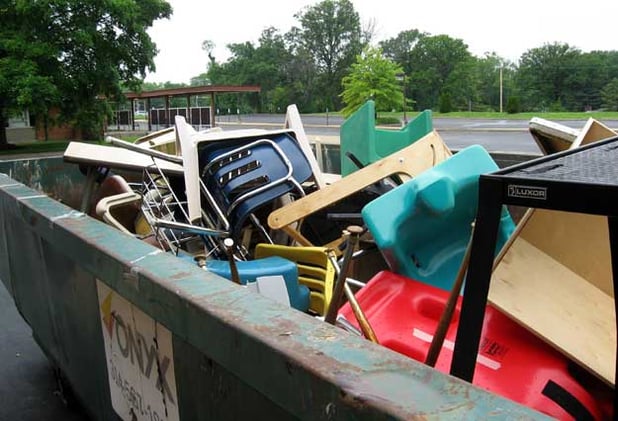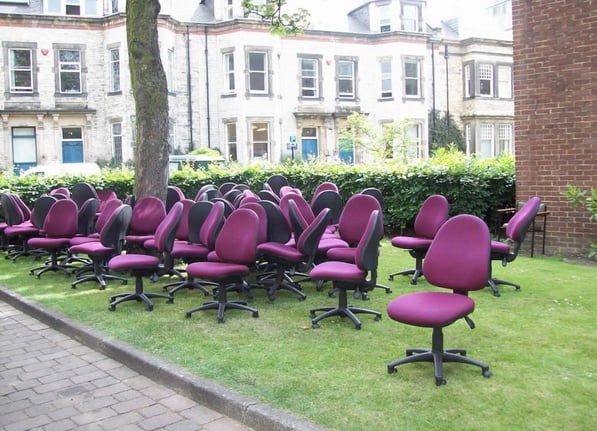I am going to start with a shocking image! This occurs in every large estate and it is all down to getting the timing of wants and needs wrong!
|
Have you seen this occur on your estate?
By the time that assets get to the porters or facilities operatives it is usually too late. A simple tweak to your disposal policy with some logical persuasion can stop this happening. Let’s talk about the way some assets are disposed of...
|
|
In large organisations, generally if somebody wants to dispose of an item, they'll call a porter or a logistics person or equivalent, fill in an online form or call the help desk. The porter/s will turn up, take the item away and in the worst case scenario, the item will get scrapped. That means it’s going in a skip or dumpster. |
|
Two huge value losses occur in this case.
Also potentially the porter may have to dismantle the item- so there's a time demand and / or injury risk! Double Whammy! In the right conditions this disposal could have actually been a win, passing of spare assets onto a person who wanted a new item. |
 |
|
Perfect world scenario? How about if you could match a disposer of an asset with a new home on the same estate without impacting on time scales? Timing is a big factor affecting reuse. We all know everyone leaves everything until the last minute- so there is no time to find a home for assets. However with some change to policy and some clever tech we can match disposers with recipients in real time and even in the future. The Warp It way! |
|
You could improve your waste disposal procedure by changing from the following; staff member calls the help desk, fills an online form to request disposal immediately, to the following; instead of the staff member spending 30 to 60 seconds of their life ordering a disposal, they log on to the Warp It reuse system. On the reuse system they input details of the asset, for example, 20 chairs. It takes anywhere between 20 and 60 seconds to enter that information. Those chairs, by way of an online marketplace, are advertised to the rest of the organisation as being surplus to requirements. Now, in most cases, that marketplace will find a match straight away because of a thing called ‘Wishlists’, which tracks desired items and pairs them to new listings. Wondering how we add items on Warp It? See here.
|
|
The new owner of the asset, who has claimed it on the reuse system, then gets an email advising them what to do next. The process starts with a call to the help desk, or to fill in an online form asking the porter to take the asset from point of disposal to point of new use. In doing this, instead of scrapping assets or sending them to storage, you've found them a home straight away on the estate. This is a double win; waste cost disposal and procurement cost avoided. There’s no extra work.
The logic for a much better Waste Disposal Strategy |
|
It is challenging to change processes. Here is the logic for changing the waste disposal policy if the sustainability argument and ethical argument don't already inspire a transition. The policy change is as follows. Anyone disposing of assets should add them to the reuse system. The persuasion for this change is as follows.
How to implement the change ‘How do you implement this policy change?’, you might be asking. There's a few ways of doing it. You can be hard line and change the waste policy with one to three months notice with some mass communications. So from one clearly defined point in the future, the porters will stop carrying out traditional disposals. |
|
Using this logic and approach, coupled with comprehensive communication to your staff, you can change your waste disposal strategy. By implementing this simple change you will change behaviour and mindset. You will avoid double handling and save time and injuries to porters. You will avoid purchasing costs and hassles. You’ll avoid waste charges. This one simple waste disposal policy change can work wonders for your sustainability and financial strategy. |
|
You can be hard line and change the waste policy with one to three months notice with some mass communications. So from one clearly defined point in the future, the porters will stop carrying out traditional disposals. Alternatively, you can take a more ‘softly softly’ approach, whereby staff are given 1-3 more traditional disposals. Each time they are served with a notification that the waste policy will change. For example, if I were to dispose of some chairs, I would call the help desk or fill in an online form and the disposal would be carried out, but I would receive a warning, saying something along the lines of ‘next time you do this please be advised you need to add this asset to your re-use system’. Here are out sticker templates to help you make this change.
|
|
Using this logic and approach, coupled with comprehensive communication to your staff, you can change your waste disposal strategy- which in turn will help with your sustainability strategy, sustainable purchasing strategy or circular economy strategy. By implementing this simple change you will change behaviour and mindset. You will avoid double handling and save time and injuries to porters. You will avoid purchasing costs and hassles. You’ll avoid waste charges. This one simple waste disposal policy change can work wonders for your sustainability and financial strategy.
Please see here to read about reuse policy and download our reuse policy template below.
|












